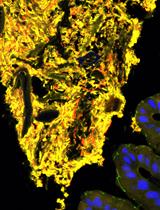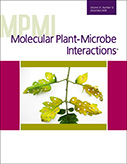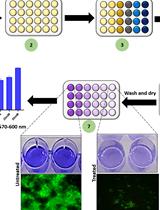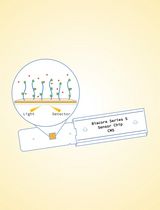- EN - English
- CN - 中文
Biofilm Formation Assay in Pseudomonas syringae
丁香假单胞菌的生物膜形成实验
发布: 2019年05月20日第9卷第10期 DOI: 10.21769/BioProtoc.3237 浏览次数: 13609
评审: Anastasia D GaziAnonymous reviewer(s)

相关实验方案

从沙门氏菌鼠伤寒血清中纯化细菌淀粉样蛋白“Curli”并检测受感染宿主组织中的 Curli
Murugesan Sivaranjani [...] Aaron P. White
2022年05月20日 3133 阅读
Abstract
Pseudomonas syringae is a model plant pathogen that infects more than 50 plant species worldwide, thus leading to significant yield loss. Pseudomonas biofilm always adheres to the surfaces of medical devices or host cells, thereby contributing to infection. Biofilm formation can be visualized on numerous matrixes, including coverslips, silicone tubes, polypropylene and polystyrene. Confocal laser scanning microscopy can be used to visualize and analyze biofilm structure. In this study, we modified and applied the current method of P. aeruginosa biofilm measurement to P. syringae, and developed a convenient protocol to visualize P. syringae biofilm formation using a borosilicate glass tube as the matrix coupled with crystal violet staining.
Keywords: Biofilm (生物膜)Background
Most Pseudomonas strains secrete exopolysaccharides, such as alginate, which is an important matrix molecule for biofilm formation (Hentzer et al., 2001; Nivens et al., 2001). Biofilm formed by the human pathogen P. aeruginosa plays important roles in its virulence and antibiotic resistance, and contributes to acute or chronic infections (Donlan and Costerton, 2002).
To date, various methods have been reported for biofilm characterization and quantification. Originally, biofilms were detected in microtiter plates made of polystyrene or polypropylene (O'Toole and Kolter, 1998; Merritt et al., 2005). During the growth of P. aeruginosa on a surface, the expression of genes involved in extracellular polysaccharide synthesis is induced (Davies et al., 1993; Davies et al., 1995), which promotes the adherence of cells to the surface. Crystal violet specifically stains the bacterial cells, and has been developed as a widely used dye for bacterial biofilm (George et al., 1998). Some recent studies have analyzed biofilm structure in a flow chamber coupled with confocal laser scanning microscopy (Sternberg and Tolker-Nielsen, 2006; Chua et al., 2016).
Biofilms formed by P. syringae strains have also been found in plant tissues (Osman et al., 1986; Fakhr et al., 1999; Preston et al., 2001). Alginate produced by P. syringae is an important polymer for P. syringae biofilm formation and contributes to its virulence and fitness, indicating its importance in plant-pathogen interaction (Preston et al., 2001; Engl et al., 2014). The formation of P. syringae and P. fluorescens biofilms can also be measured using crystal violet staining in microwell plates (Carezzano et al., 2017; Zhu et al., 2018; Patange et al., 2019).
In this study, we modified and applied the current method of P. aeruginosa biofilm measurement to P. syringae (Kong et al., 2015; Zhao et al., 2016; Shao et al., 2018). We present an economic, rapid and visual biofilm detection protocol that combines the use of borosilicate glass tubes and crystal violet staining methods, which have been efficiently used in our recent studies (Wang et al., 2018; Wang et al., 2019; Xie et al., 2019) for visualizing the biofilm of the model plant pathogen P. syringae.
Materials and Reagents
- 10 ml Borosilicate glass tube (ISOLAB, catalog number: 077.02.003)
- 14 ml sterile tube (SPL Lifescience, catalog number: 40014)
- Filter (PALL Lifesciences, catalog number: AP-4219)
- Strains P. syringae pv. phaseolicola 1448A (Psph) (Xiao et al., 2007) and rhpS deletion mutant (ΔrhpS) (Xie et al., 2019)
- NaOH (UNI-CHEM, catalog number: 1310-73-2)
- MgSO4·7H2O (Aladdin, catalog number: 10025-84-0)
- K2HPO4 (Aladdin, catalog number: 7758-11-4)
- BactoTM Proteose peptone No.3 (AOBOX, catalog number: 01-049)
- Rifampin (Aladdin, catalog number: 13292-46-1)
- Agar (MP Biomedicals, catalog number: 9002-18-0)
- Crystal violet (Beijing Dingguo, catalog number: 548-62-9)
- Glycerol (Beijing Bailingwei, catalog number: 262536)
- 100% ethanol (Honeywell, catalog number: 32221-2.5L)
- King's B (KB) (see Recipes)
Equipment
- 1 ml pipette (Eppendorf, catalog number: 3123000063)
- Benchtop shaking incubator (Labwit Scientific, model: ZWYR-240)
- Constant temperature incubator (Labwit Scientific, model: ZXDP-B2120)
- EvolutionTM 350 UV-Vis Spectrophotometer (Thermo Fisher Scientific, catalog number: 912A0959)
- SynergyTM 2 Multi-Mode Microplate Reader (BioTek)
- Test tube stand (ISOLAB, catalog number: 079.01.005)
- -80 °C freezer (Thermo Scientific, catalog number: 5IDTSX)
Software
- Microsoft Office Excel 2016 and GraphPad Prism 8.0.2.
Procedure
文章信息
版权信息
© 2019 The Authors; exclusive licensee Bio-protocol LLC.
如何引用
Shao, X., Xie, Y., Zhang, Y. and Deng, X. (2019). Biofilm Formation Assay in Pseudomonas syringae. Bio-protocol 9(10): e3237. DOI: 10.21769/BioProtoc.3237.
分类
微生物学 > 微生物生物膜 > 生物膜培养
生物化学 > 糖类 > 多糖
您对这篇实验方法有问题吗?
在此处发布您的问题,我们将邀请本文作者来回答。同时,我们会将您的问题发布到Bio-protocol Exchange,以便寻求社区成员的帮助。
Share
Bluesky
X
Copy link












